Research Archive
 |
Where I'm From: ITEP Creative Writing 2005-2013Bill Robertson, editor
|
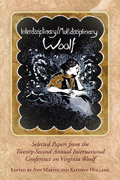 |
Interdisciplinary / Multidisciplinary Woolf: The Selected Papers of the 22nd Annual International Conference on Virginia WoolfAnn Martin, editor (with Kathryn Holland) From Clemson: Interdisciplinary/Multidisciplinary Woolf comprises thirty-five essays selected from papers delivered at the 22nd Annual International Conference on Virginia Woolf, hosted by the University of Saskatchewan. Contributors link inter- and multidisciplinary scholarship to the intellectual and creative projects of Woolf and her modernist peers. Essays that identify and extend points of contact between literary studies and varied disciplines are arranged in four thematic sections: "History, Materiality, Multiplicity"; "Patterns, Practices, Principles"; "Art, Influence, Embodiment"; and "Publishing, Politics, Publics." This collection contains writing by established and emergent scholars. |
James VI and I, Scotland and LiteratureDavid Parkinson, Editor From Peeters: This volume offers a broadly conceived sequence of perspectives on cultural change, principally in Scotland and from Scottish perspectives, during the long reign of King James VI and I. The contributors to this volume include established and new scholars in early modern history and literary studies from Italy, the Netherlands, and the United Kingdom, as well as Canada and the United States. From the perspectives they provide, the cultural changes of the reign of James VI and I emerge out of a colloquy between the king and his realms, a colloquy in which each of the participants is undergoing a transformation. |
|
 |
Digitizing Medieval and Early Modern Material Culture. New Technologies in Medieval and Renaissance Studies, Vol. 3Brent Nelson (University of Saskatchewan) and Melissa Terras (University College London), eds. Digital technologies are changing the way in which we can understand and analyse history and its associated artefacts. The aim of this book is to encapsulate the potential that digital technologies pose for Medieval Material Culture, providing examples of leading projects worldwide which are enabling new forms of research in this area. The text aims to provide a broad overview of the type of tools now used by historians – such as text encoding, digitization, and visualization, juxtaposing this with core concerns from historians investigating particular research questions. As such, it draws together a key body of research in this area, demonstrating how digital tools and techniques can aid in changing our understanding of the past. |
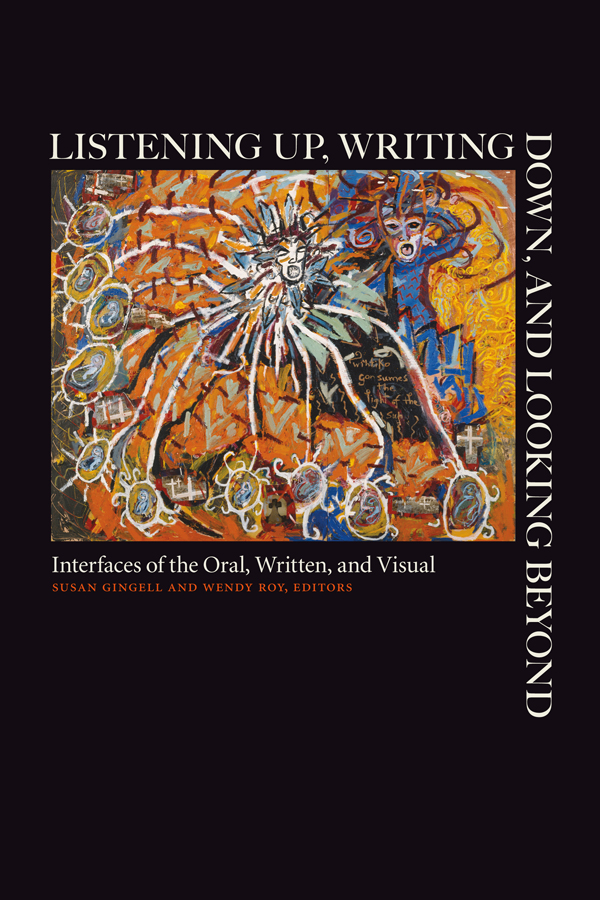 |
Listening Up, Writing Down, and Looking Beyond: Interfaces of the Oral, Written, and VisualSusan Gingell and Wendy Roy, Editors From WLU Press: Listening Up, Writing Down, and Looking Beyond is an interdisciplinary collection that gathers the work of scholars and performance practitioners who together explore questions about the oral, written, and visual. The book includes the voices of oral performance practitioners, while the scholarship of many of the academic contributors is informed by their participation in oral storytelling, whether as poets, singers, or visual artists. Its contributions address the politics and ethics of the utterance and text: textualizing orature and orality, simulations of the oral, the poetics of performance, and reconstructions of the oral. |
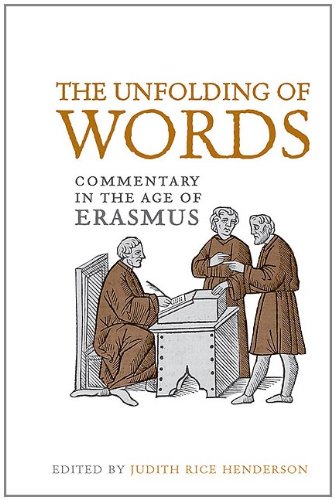 |
The Unfolding of Words: Commentary in the Age of ErasmusJudith Rice Henderson, Editor From U of T Press: Leading sixteenth-century scholars such as Martin Luther and Desiderius Erasmus used print technology to engage in dialogue and debate with authoritative contemporary texts. By what Juan Luis Vives termed 'the unfolding of words, ' these humanists gave old works new meanings in brief notes and extensive commentaries, full paraphrases, or translations. This critique challenged the Middle Ages deference to authors and authorship and resulted in some of the most original thought - and most violent controversy - of the Renaissance and Reformation. The Unfolding of Words brings together international scholarship to explore crucial changes in writers' interactions with religious and classical texts. This collection focuses particularly on commentaries by Erasmus, contextualizing his Annotations and Paraphrases on the New Testament against broader currents and works by such contemporaries as François Rabelais and Jodocus Badius. The Unfolding of Words tracks humanist explorations of the possibilities of the page that led to the modern dictionary, encyclopedia, and scholarly edition. |
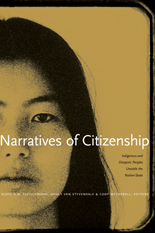 |
Narratives of Citizenship: Indigenous and Diasporic Peoples Unsettle the Nation-State
Aloys N.M. Fleischmann and Nancy Van Styvendale, Editors (with Cody McCarroll) From U of A Press: Examining various cultural products—music, cartoons, travel guides, ideographic treaties, film, and especially the literary arts—the contributors of these thirteen essays invite readers to conceptualize citizenship as a narrative construct, both in Canada and beyond. Focusing on indigenous and diasporic works, along with mass media depictions of Indigenous and diasporic peoples, this collection problematizes the juridical, political, and cultural ideal of universal citizenship. Readers are asked to envision the nation-state as a product of constant tension between coercive practices of exclusion and assimilation. Narratives of Citizenship is a vital contribution to the growing scholarship on narrative, nationalism, and globalization. |
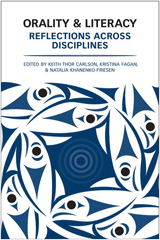 |
Orality and Literacy: Reflections Across DisciplinesKristina Fagan, Editor (with Keith Thor Carlson and Natalia Khanenko-Friesen) From U of T Press: Orality and Literacy investigates the interactions of the oral and the literate through close studies of particular cultures at specific historical moments. Rejecting the 'great-divide' theory of orality and literacy as separate and opposite to one another, the contributors posit that whatever meanings the two concepts have are products of their ever-changing relationships to one another. Through topics as diverse as Aboriginal Canadian societies, Ukrainian-Canadian narratives, and communities in ancient Greece, Medieval Europe, and twentieth-century Asia, these cross-disciplinary essays reveal the powerful ways in which cultural assumptions, such as those about truth, disclosure, performance, privacy, and ethics, can affect a society's uses of and approaches to both the written and the oral. The fresh perspectives in Orality and Literacy reinvigorate the subject, illuminating complex interrelationships rather than relying on universal generalizations about how literacy and orality function. |
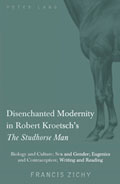 |
Disenchanted Modernity in Robert Kroetsch's The Studhorse Man: Biology and Culture; Sex and Gender; Eugenics and Contraception; Writing and ReadingFrancis Zichy From Peter Lang: This book undertakes a detailed reading of Robert Kroetsch's The Studhorse Man, examining this Canadian novel in its transnational historical and socio-cultural context. Key subject headings are biology and culture, sex and gender, eugenics and contraception, writing and reading. The overarching theme is "disenchanted modernity" in the twentieth-century, the systematic displacement of the divine and natural order by a humanly ordained social regime, and by forms of social engineering that brought to bear the full force of modern science, invasively to alter the most fundamental conditions of human life. The more immediate literary frames of reference are Greek mythology, early Christian debates on the body and marriage, and the lore of the North American Aboriginal trickster, as these are deployed and alluded to in Kroetsch's novel. In establishing the sources and contexts of The Studhorse Man, this study examines Robert Kroetsch's early drafts of the novel, and his many notes taken and clippings assembled during its composition. An effort has been made to appeal to a wide range of general and academic readers alike by avoiding specialized jargon and adopting a cross-disciplinary approach. This book will be of interest to scholars of literature and literary theory, and of use in courses on literature and the novel, on masculinity and gender studies, and on cultural history in the twentieth century. |
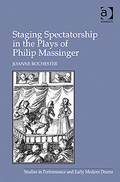 |
Staging Spectatorship in the Plays of Philip MassingerJoanne Rochester From Ashgate: The playwrights composing for the London stage between 1580 and 1642 repeatedly staged plays-within and other metatheatrical inserts. Such works present fictionalized spectators as well as performers, providing images of the audience-stage interaction within the theatre. They are as much enactments of the interpretive work of a spectator as of acting, and as such they are a potential source of information about early modern conceptions of audiences, spectatorship and perception. This study examines on-stage spectatorship in three plays by Philip Massinger, head playwright for the King's Men from 1625 to 1640. Each play presents a different form of metatheatrical inset, from the plays-within of The Roman Actor (1626), to the masques-within of The City Madam (1632) to the titular miniature portrait of The Picture (1629), moving thematically from spectator interpretations of dramatic performance, the visual spectacle of the masque to staged 'readings' of static visual art. All three forms present a dramatization of the process of examination, and allow an analysis of Massinger's assumptions about interpretation, perception and spectator response. |
 |
Robert Henryson, The Complete WorksDavid J. Parkinson From TEAMS: In this new edition of the poems of Robert Henryson, David Parkinson offers editions of Henryson's Fables, The Testament of Cresseid, Orpheus and Eurydice, and twelve shorter poems (grouped according to the strength of their attribution to Henryson), as well as the glosses and explanatory and textual notes characteristic of Middle English Texts Series volumes. In an extensive introduction, Parkinson discusses what is known of Henryson's life, the publication history of the poems, and Henryson's language. As Parkinson notes, "Henryson's poems involve an ongoing concern with the function of poetry itself as a blend of truth and fiction in a world in which falsehood is the wellspring of corruption; in operation, the figure of the poet may be analogous to the foxes he repeatedly places at the center of his narratives. Hence arises an abiding concern about the abuses of the natural capacity for playful imitation, for selfish ends." |
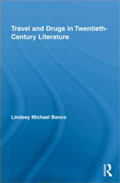 |
Travel and Drugs in Twentieth-Century LiteratureLindsey Michael Banco From Routledge: This book examines the connections between two disparate yet persistently bound thematics—mobility and intoxication—and explores their central yet frequently misunderstood role in constructing subjectivity following the 1960s. Emerging from profound mid-twentieth-century changes in how drugs and travel were imagined, the conceptual nexus discussed sheds new light on British and North American responses to sixties counterculture. With readings of Aldous Huxley, William Burroughs, Alex Garland, Hunter S. Thompson, and Robert Sedlack, Banco traces twin arguments, looking at the ways travel is imagined as a disciplinary force acting upon the creative, destabilizing powers of psychedelic intoxication; and exploring the ways drugs help construct travel spaces and practices as, at times, revolutionary, and at other times, neo-colonial. By following a sequence of shifting understandings of drug and travel orthodoxies, this book traverses fraught and irresistibly linked terrains from the late 1950s up to a period marked by international, postmodern tourism. As such, it helps illuminate a world where tourism is continually expanding yet constantly circumscribed, and where illegal drugs are both increasingly unregulated in the global economy and perceived more and more as crucial agents in the construction of human subjectivity. |
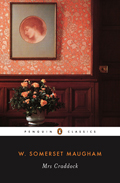 |
Mrs Craddock, by W. Somerset MaughamRobert Calder, Introduction and Notes
|
 |
Depression and Narrative: Telling the DarkHilary Clark, Editor From SUNY Press: Depression and Narrative examines stories of depression in the context of recent scholarship on illness and narrative, which up to this point has largely focused on physical illness and disability. Contributors from a number of disciplinary perspectives address these narrative accounts of depression, by both sufferers and those who treat them, as they appear in memoirs, diaries, novels, poems, oral interviews, fact sheets, blogs, films, and television shows. Together, they explore the stories we tell about depression: its contested causes; its gendering; the transformations in identity that it entails; and the problems it presents for communication, associated as it is with stigma and shame. Unlike certain physical illnesses, such as cancer, depression is stigmatized—sometimes as a nonproblem (the sufferer should "snap out of it") and sometimes as the slippery slope to madness. Thus, depression narratives have their work cut out for them. This book highlights the work these stories do, including bringing meaning to sufferers, explaining depression, justifying therapies and treatments, and reducing the burden of shame—accounting for a suffering that is, in the end, unaccountable. |
 |
The Magician, by W. Somerset MaughamRobert Calder, Introduction and Notes From Penguin: Maugham's enchanting tale of secrets and fatal attraction. The Magician is one of Somerset Maugham's most complex and perceptive novels. Running through it is the theme of evil, deftly woven into a story as memorable for its action as for its astonishingly vivid characters. In fin de siecle Paris, Arthur and Margaret are engaged to be married. Everyone approves and everyone seems to be enjoying themselves—until the sinister and repulsive Oliver Haddo appears. |
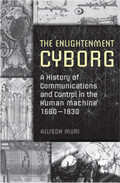 |
The Enlightenment Cyborg: A History of Communications and Control in the Human Machine, 1660–1830Allison Muri From U of T Press: For many cultural theorists, the concept of the cyborg—an organism controlled by mechanic processes—is firmly rooted in the post-modern, post-industrial, post-Enlightenment, post-nature, post-gender, or post-human culture of the late twentieth century. Allison Muri argues, however, that there is a long and rich tradition of art and philosophy that explores the equivalence of human and machine, and that the cybernetic organism as both a literary figure and an anatomical model has, in fact, existed since the Enlightenment. In The Enlightenment Cyborg, Muri presents cultural evidence—in literary, philosophical, scientific, and medical texts—for the existence of mechanically steered, or ‘cyber’ humans in the works seventeenth- and eighteenth-century thinkers. Muri illustrates how Enlightenment exploration of the notion of the ‘man-machine’ was inextricably tied to ideas of reproduction, government, individual autonomy, and the soul, demonstrating an early connection between scientific theory and social and political thought. She argues that late twentieth-century social and political movements, such as socialism, feminism, and even conservatism, are thus not unique in their use of the cyborg as a politicized trope. |
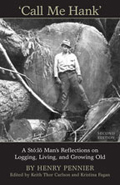 |
'Call Me Hank': A Stó:lõ Man's Reflections on Logging, Living, and Growing OldKristina Fagan, Editor (with Keith Thor Carlson, History) From U of T Press: ‘My name is Henry George Pennier and if you want to be a friend of mine please you will call me Hank.’ So begins ‘Call Me Hank,’ the autobiography of Hank Pennier (1904–1991): logger, storyteller, and self-described ‘halfbreed.’ In this work, Pennier offers thoughtful reflections on growing up as a non-status Aboriginal person on or near a Stó:lõ reserve, searching for work of all kinds during hard times as a young man, and working as a logger through the depression of the 1930s up to his retirement. Known only to a small local audience when it was first published in 1972, this expanded edition of Pennier’s autobiography provides poignant political commentary on issues of race, labour, and life through the eyes of a retired West Coast Native logger. ‘Call Me Hank’ is an engaging and often humorous read that makes an important contribution to a host of contemporary discourses in Canada, including discussions about the nature and value of Aboriginal identity. To Hank’s original manuscript, Keith Carlson and Kristina Fagan have added a scholarly introduction situating Hank’s writing within historical, literary, and cultural contexts, exploring his ideas and writing style, and offering further information about his life. A map of place names mentioned by Hank, a diagram of a steam logging operation, a glossary of logging terms, and sixteen photographs provide practical and historical complements to Pennier’s original lively personal narrative. |
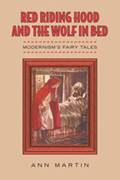 |
Red Riding Hood and the Wolf in Bed: Modernism's Fairy TalesAnn Martin From U of T Press: From children’s books to Christmas pantomimes, and from scholarly anthologies to movies, the many and various adaptations of fairy tales in the late-nineteenth and early twentieth centuries speak to the genre’s widespread popularity. Narratives whose presence and appeal can be traced through every aspect of modern British and North American culture, fairy tales invite a range of interpretations and applications, as multiple versions of ‘Cinderella,’ ‘Sleeping Beauty,’ and ‘Little Red Riding Hood’ enable multiple and potentially subversive uses of their plots and motifs by writers and readers alike. By exploring representations of fairy tales in the works of James Joyce, Virginia Woolf, and Djuna Barnes, Ann Martin’s Red Riding Hood and the Wolf in Bed asserts the significance of the stories as a system of reference for these and other modernists. Allusions to fairy tales in works such as Ulysses, Orlando, and Nightwood signify not only an intersection of popular culture and high modernism, but also an interaction between modern subjects and their social and economic contexts. Drawing on theoretical paradigms from gender and cultural studies, Martin develops a participatory model of modernist literature and culture. The tactical engagements with social normatives that are found in fairy tales and in the modernist texts echo the authors’ own challenges to formal and discursive boundaries through intertextuality, just as the readers of the fairy tale allusions become actively engaged in making sense of modernism. |
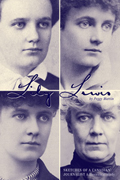 |
Lily Lewis: Sketches of a Canadian JournalistPeggy Martin From U of C Press: Under the pseudonym Louis Lloyd, writer and journalist Lily Lewis was regularly featured in the newspaper The Week, and her hugely popular column “Montreal Letter” was for some time a staple in the Toronto newspaper. She also accompanied writer Sara Jeannette Duncan on a journey around the world which later became the subject of Duncan’s fictional work, in which Lewis was immortalized as a character. Lewis’s subsequent work has largely been overlooked, though she continued to publish a variety of work from her home in Paris until 1912. Part critical study, part biography, Martin’s book examines the published work and private letters of Lily Lewis in an attempt to reconstruct this important figure in turn-of-the-century Canadian journalism. Lily Lewis: Sketches of a Canadian Journalist puts into context the uniquely feminine aspects of this writer’s life, outlining the prevalence of social concerns and domestic themes, but also the more typically masculine domain of European art and culture, prompting a serious re-evaluation of Canadian feminist expression in the nineteenth century. |
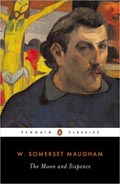 |
The Moon and Sixpence, by W. Somerset MaughamRobert Calder, Introduction and Notes Penguin Classics, 2005 From Penguin: The Moon and Sixpence, published in 1919, was one of the novels that galvanized W. Somerset Maugham’s reputation as a literary master. It follows the life of one Charles Strickland, a bourgeois city gent whose dull exterior conceals the soul of a genius. Compulsive and impassioned, he abandons his home, wife, and children to devote himself slavishly to painting. In a tiny studio in Paris, he fills canvas after canvas, refusing to sell or even exhibit his work. Beset by poverty, sickness, and his own intransigent, unscrupulous nature, he drifts to Tahiti, where, even after being blinded by leprosy, he produces some of his most extraordinary works of art. Inspired by the life of Paul Gauguin, The Moon and Sixpence is an unforgettable study of a man possessed by the need to create—regardless of the cost to himself and to others. |
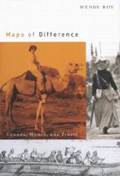 |
Maps of Difference: Canada, Women, and TravelWendy Roy From McGill-Queen's: As well as providing vivid and sympathetic accounts of geography, peoples, and cultures, three women writers use their books to chart their own historical and social positions. In Maps of Difference Wendy Roy explores the ways in which Anna Jameson, Mina Hubbard, and Margaret Laurence were attuned to the cultural imperialism underlying their travel writing. Roy considers the connections Jameson makes between feminism and anti-racism in Winter Studies and Summer Rambles in Canada (1838), Hubbard's insights in A Woman's Way Through Unknown Labrador (1908) into her relationship with First Nations men who had both more and less power than she, and Laurence's awareness of colonial and patriarchical oppression in her African memoir The Prophet's Camel Bell (1963). Roy also examines archival and First Nations accounts of these women's travels, and the sketches, photos, and maps that accompany their writing, to examine contradictions in and question the implied objectivity of travel narratives. She concludes by looking at the myth of getting there first and the ways in which new technologies of representation, including cameras, allow travellers and writers to claim new travel firsts. |
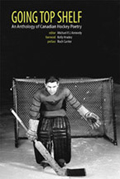 |
Going Top Shelf: An Anthology of Canadian Hockey PoetryMichael P.J. Kennedy, Editor From Heritage House: Going Top Shelf brings together for the first time in one collection some of Canada’s best hockey poems and song lyrics. Included are works by such outstanding Canadian poets as Michael Ondaatje, Al Purdy, Margaret Avison, Don Gutteridge, and Lorna Crozier. And for music lovers with a taste for contemporary Canadian music, this entertaining collection includes lyrics by The Tragically Hip, The Rheostatics, Kathleen Edwards, Stompin’ Tom Connors, and others. Going Top Shelf represents a cross-section of Canada’s poets and composers ranging from 19th century romantic poet Sir Charles G.C. Roberts to contemporary pop songstress Jane Siberry. Altogether, more than 30 authors and songwriters from across Canada reflect an intriguing diversity of forms and literary expression. Yet, in all the poems, ice, or the sport played to extensively in Canada upon it, is used to express the ideas, beliefs, and attitudes of this diverse group of Canadian authors. |
 |
Holy Ambition: Rhetoric, Courtship, and Devotion in the Sermons of John DonneBrent Nelson From MRTS: This study examines the rich resource for rhetorical invention that Donne found in the contemporary culture of courtship. The first half of the book employs the theories of Kenneth Burke in tandem with ancient and early-modern rhetorical theory to examine Elizabethan and Jacobean expressions of social desire (sexual, political, economic, etc.). It demonstrates how Donne employed these modes of courtship to stimulate and direct his audience's thought and desire with respect to matters of religious devotion. The second half of the book applies this socio-rhetorical paradigm of courtship in close readings of three Donne sermons. This study will be of interest to scholars and students of early-modern literature and rhetoric and to those interested in homiletics and devotional literature. |
 |
A Richer Dust: Family, Memory and the Second World WarRobert Calder From Viking Penguin: When Captain Ken Calder returned home to Canada after five years of fighting in WWII, the last thing he expected to find was another man living with his wife. Three weeks later, the Saskatchewan soldier mailed a suicide note to his closest wartime buddy and took his own life. Fifty years later, Calder's two nephews finally got to read that note. In A Richer Dust, author Robert Calder uses his uncle's wartime journal and letters, as well as newspaper accounts and military memoirs to vividly recreate the horrendous battlefield conditions in Italy and Holland. Amid bombs and artillery fire, amid seas of mud and endless rain, soldiers kept alive a vision of home and hearth to keep them going. In Ken Calder's case, as in many other instances, that vision proved to be an illusion. A Richer Dust explores the profound effect that the suicide had on Captain Calder's parents, the brother whose alcoholism led to his being institutionalized, and the two boys who grew up idealizing their soldier uncle. It is a powerful exploration of a case of unrecognized post-traumatic stress and a profoundly moving account of war and its aftermath. |
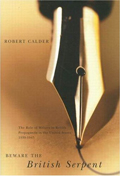 |
Beware the British Serpent: The Role of Writers in British Propaganda in the United States, 1939-1945Robert Calder From McGill-Queen's: During World War II, the United States was the target of what Gore Vidal has called "the largest, most intricate and finally most successful conspiracy directed at it in the twentieth century" - Great Britain's "vast conspiracy to manoeuvre an essentially isolationist country into the war." In Beware the British Serpent Robert Calder examines British writers' involvement in this propaganda campaign, including lecturing and touring in the United States, broadcasting on American radio, writing screenplays for films such as Mrs. Miniver and This Above All, and writing articles and books for publication in America. Using newly uncovered archival material, Calder offers provocative new insights into the war work of more than forty prominent British authors, focusing particularly on Somerset Maugham, Noel Coward, H.G. Wells, Vera Brittain, and J.B. Priestley. He provides a comprehensive analysis of the suspicions beneath the wartime Anglo-American alliance and describes the tensions that arose between the British Ministry of Information and the Foreign Office over the nature and direction of the propaganda campaign in the United States.Calder demonstrates that Britain's well-organized propaganda campaign in the United States to persuade it to enter World War I had left isolationist and Anglophobic Americans highly suspicious of anything that hinted of propaganda. Any effort to influence public opinion had therefore to be carefully and subtly undertaken, and the British Government soon realised that well-known authors - employed officially or semi-officially - were ideal for the task. Respected for their pens, they were especially suited to reminding Americans of their strongest links with Britain - a common language and a shared cultural heritage of Shakespeare, Dickens, Austen, Hardy, Thackeray, and others. As well, their profession had often led them to tour, speak, write, and live in America, and, because they could live on their royalties and speaking fees, they were not on the payroll of the British government and thus could not be identified as paid foreign agents. |
 |
'Full of all knowledg': George Herbert's Country Parson and Early Modern Social DiscourseRon Cooley George Herbert is best known as a seventeenth-century sacred poet, often associated with such writers as John Milton and John Donne, but it is Herbert's portrait of an idealized rural clergyman in The Country Parson which perhaps best shows Herbert's engagement in a wide range of complex social debates. In Full of all knowledg, Ronald Cooley examines the 1632 pastoral manual through four distinct lenses, each representing the perspective of a particular historical sub-specialty: church history, the history of the 'learned professions' (law and medicine), local and agricultural history, and the history of the patriarchal nuclear family. Cooley argues that in Herbert's portrait of the clergyman who is 'full of all knowledge,' and who counsels parishioners on matters of faith, law, health, agriculture, and family obligation, Herbert engages with contemporary cultural and social ideals, and offers today's scholar a unique opportunity for synthetic literary-historical study. Through his investigation of The Country Parson and a selection of Herbert's later poems, Cooley shows how traditionalist rhetoric and appeals to customary wisdom facilitated innovative practices in agricultural, professional, social, and domestic affairs, and he provides new illumination of the mental and material world of the seventeenth century cleric and poet. In positioning George Herbert as a spokesman for a legal-rational social order, and in placing The Country Parson in its cultural milieu, Cooley reveals a new dimension to Herbert's work and provides a valuable tool for future study of Herbert and seventeenth-century culture and history. |
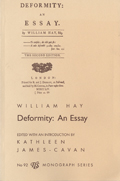 |
Deformity: An Essay, by William HayKathleen James Cavan, Editor |
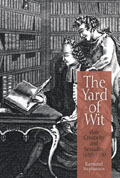 |
The Yard of Wit: Male Creativity and Sexuality, 1650-1750Raymond Stephanson From U Penn Press: Literary composition is more than an intellectual affair. Poetry has long been said to spring from the heart, while aspiring writers are frequently encouraged to write "from the gut." Still another formulation likens the poetic imagination to the pregnant womb, in spite of the fact that most poets historically have been male. Offering a rather different set of arguments about the forces that shape creativity, Raymond Stephanson examines how male writers of the Enlightenment imagined the origins, nature, and structures of their own creative impulses as residing in their virility. For Stephanson, the links between male writing, the social contexts of masculinity, and the male body—particularly the genitalia—played a significant role in the self-fashioning of several generations of male authors. Positioning sexuality as a volatile mechanism in the development of creative energy, The Yard of Wit explains why male writers associated their authorial work—both the internal site of creativity and its status in public—with their genitalia and reproductive and erotic acts, and how these gestures functioned in the new marketplace of letters. Using the figure and writings of Alexander Pope as a touchstone, Stephanson offers an inspired reading of an important historical convergence, a double commodification of male creativity and of masculinity as the sexualized male body. |
 |
The Future of the PagePeter Stoicheff, Editor (with Andrew Taylor, University of Ottawa) From U of T Press: The most basic unit of the physical book is the page. It has determined the historical evolution of the book, the types of information communicated, and how the audience accesses that information. Unique and rewarding in both its scope and approach, The Future of the Page is a collection of essays that presents the best of recent critical theory on the history and future of the page and its enormous influence on Western thought and culture. Spanning the centuries between the earliest record of the page and current computerized conceptions of page-like entities, the essays examine the size of the page, its relative dimensions, materials, design, and display of information. The page is broadly defined, allowing the volume to explore topics ranging from medieval manuscripts to non-European alternatives to the page, Algonquin symbolic literacy, and hypertext. This thought-provoking collection will appeal to literary scholars, book historians, graphic designers, and those interested in the impact of evolving print technologies on intellectual and cultural life. |